"Oasis Salsero"
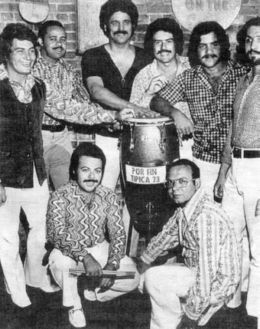

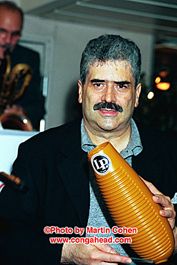
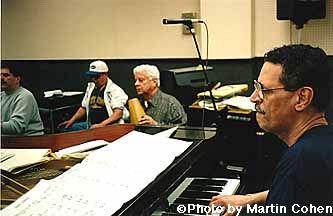


With the blessing of Fania's president Jerry Masucci, who saw top rank potential
on the group (and the presence of two original Fania All-Stars members in the
lineup didn't hurt either), they recorded their first album on the Inca label,
one of the many Fania subsidiaries back then. And, despite the unfavorable odds
(mostly due to the fact that more than 50% of the band's personnel came from
Barretto's band), it was an instant success. Sure, it was kind of logical and
predictable that comparisons between Barretto's "Cocinando" band and
its newly formed off-shoot would arise. But they surprised everyone with a new
sound and a new concept, as they, rather than stepping on Barretto's toes (which
would've been the easiest approach), they developed a traditional-yet-radical
approach by blending the percussive conjunto format (Rodriguez on congas and
Vilato shifting back and forth between timbales and bongo depending on the song
structure) with the new salsa sonority that demanded at least one trombonist
(Pineda, in this case) in the horn section. The Cuban-style two-percussionist
conjunto setup was a common trend during the late 60's/early 70's. Harlow's
band, for example, although it would have Manny Oquendo sitting in regularly on
timbales for the recording sessions, was actually a two-percussionist band, with
Phil Newsum doing the timbale/bongo shift. It's not necessarily a coincidence
that Ismael Miranda's very first band, Orq. Revelacion, would use this same
combination too, with Nicky Marrero as the timbale/bongo player. On his early
days as a bandleader after splitting with Willie Colon, Hector Lavoe would rely
on the conga/bongo combination of Milton Cardona/Eddie Montalvo and Jose Mangual
Jr. for his band (it wasn't until circa 1978 when he actually hired a timbalero,
Edgar Reyes, to become a regular member of the band). And then, of course, there
was the case of Johnny Pacheco, whose Nuevo Tumbao (it wasn't until later in the
70's decade that he would strategically rename his conjunto as "Tumbao
A?ejo"), following the structure and sound of Cuba's Sonora Matancera,
would always avoid the use of a timbalero. In other words and resuming, most of
the new bands in New York during the period between 1971 and 1976 would use the
conjunto structure (with only two percussionists in the rhythm section), and
Tipica'73 wasn't the exception. However, it's worth noting that Tipica'73 would
become a driving force (if not the driving force) of the 'criollo'
movement of the early 70's salsa. And, unlike other New York conjunto-based
groups from that era who either migrated to the progressive sounds imposed by Best Replica Cartier Watches
Willie Colon and Eddie Palmieri or just simply stuck there on the old Cuban
songbook, Tipica eventually came up with another option no one dared to explore:
experimenting with the new trends in Cuban music, such as songo and what then
was called "Onda Areito." (Puerto Rican based groups like those led by
Roberto Roena, Bobby Valentin and Rafael Cortijo himself would also come out
with fresher, innovative approaches, but that's theme for another essay.) They'd
also experiment with jazz, fusion and even rock elements later in the decade.
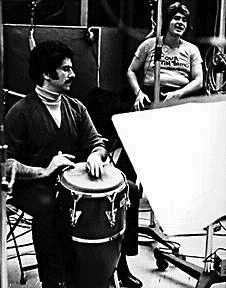
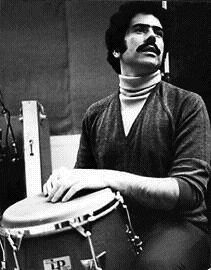
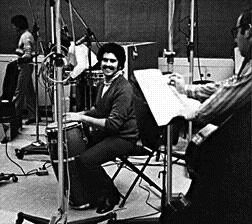
Adalberto, leader Johnny Rodriguez, and bassist Dave Perez during Tipica's first recording session (photos from Martin Cohen's collection).
From their very beginnings, Tipica'73 will focus on the Cuban side of what was
now called salsa, by bringing back elements of the guajira, pachanga, son
montuno, mozambique and Guaguanco and presenting them within the new trend, but
respecting their traditional structure. And for their first album,
"Tipica'73," they brought in plenty of evidence of their versatility
in songs like "Oye Mi Guajira," the standard "Son De La
Loma," "No Volver?," Vilato's original "Acere Bonko"
and Arsenio Rodriguez's "Tintorera" (as most of his signature tunes,
this one has a very particular double-entendre theme; Larry Harlow explains this
on an interview by David Carp published in Descarga On Line, http://www.descarga.com/).
For good measure, they added a bolero medley (which Adalberto brings to life
flawlessly), and even surprised everybody with a jazz-tinged bolero version of
"What Are You Doing The Rest Of Your Life," where lead trumpeter Rene
Lopez handles the vocal duties. The lead singles of this album were the opener
"Ma?o?o," a straight-ahead salsa tune, the brass section showcase
"No Volver?" and "Descarga'73," a vehicle for Orestes
Vilato's undisputed virtuosity on timbales. Johnny Pacheco was the producer,
although unlike other dates he'd produce for other Fania artists, here he didn't
need to give too much of an input. Not with the top cats involved here and the
raw energy they delivered in this session, only matched or surpassed by their
own performances on stage. Still today, Tipica'73's first album is one of the
best selling albums in Fania's catalog.
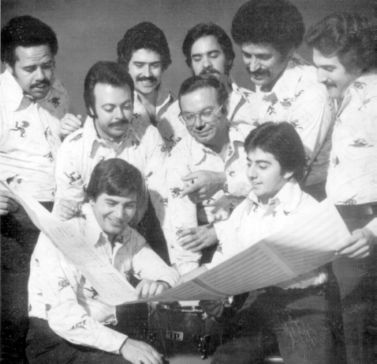
Tipica'73
promotional photo from 1974. Nelson Gonzalez (front row, seated at right) joins
the original crew that year. Photo courtesy of Fania Records.
Their sophomore album, curiously also titled "Tipica'73," followed
almost exactly the same formula of their debut album, although enhancing the
Cuban flavor with the addition of tres virtuoso Nelson Gonzalez, who
rapidly became a crucial member of the band. Gonzalez, although being part of
the And Vinny's' jam sessions from which this band evolved, didn't join the band
formally until 1974, year when Ismael Miranda's Orq. Revelacion, where he was
the co-musical director, folded. Although, once again, a straight-ahead salsa
tune (the opener "Asi No Se Quiere A Nadie") was chosen as the lead
off single, the real hit from this album was "Amalia Batista."
Originally a Cuban standard made famous by Rolando La Serie, this guaracha gets
a rare twist in Tipica's version, as at half tune and after Sonny Bravo's piano
solo, Sonny himself blends in some scat vocals, trading bars with trumpeter
Manozzi, whose solos are kind of twisted with a baritone effect as well.
Adalberto joins the spoof with a trombone impersonation and, to top it all,
Nelson and Orestes do a mocking parody of several well-known American scene
icons, all this on top of a typical Cuban style montuno. (On their live
presentations, they'll even expand on this feature by blending in parodies of
American musicals and even Top 10 pop hits like "Louie, Louie.") In
yet another proof or their radical approach to this album, the closing tune, a
Cuban style jam (descarga) showcasing Nelson's tres and Vilato's timbales was
published under a very subtle title? "Watergate" (anyone here
remembers Richard "I Quit" Nixon? I don't? I wasn't even in
kindergarten when all that exploded). The emphasis on Cuban guaracha and son
styles, rather than the already common urban salsa approach, and their
insistence on developing a more "criollo" sound within salsa's basic
structure on this album are more radical proof, and, as well, a hint on what
would be their approach for their subsequent releases. The outcome of this album
resulted in even more growing popularity for the band, as they began to tour
outside the U. S. In fact, they were engaged as an opening act for the Fania
All-Stars, although, curiously, Vilato and Adalberto, who were founding members
of the label's stellar band, were no longer included in the All-Star cast? for
a while. I wonder if Barretto ever had something to do on that regard, as I
learned that he (naturally) was clearly upset with them after losing them and
half of his crew in the process of founding Tipica. Have you ever paid a close
attention to the lyrics of Barretto's "Indestructible?" To close this
chapter, here are a few words by Adalberto on the process of stepping down from
Barretto's band and founding Tipica, translated: "It was disheartening
for all of us. We (referring to Johnny, Orestes, Rene, Dave Perez and him) let
him know about the forming of the new band, but he thought it was only our way
of asking for a raise. He never thought we were actually leaving (his
group). But, at least in my case, I left all doors open?"
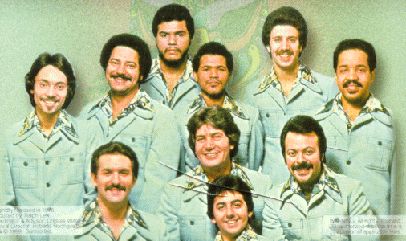 |
|
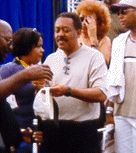 |
 |
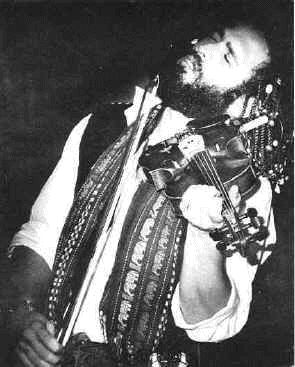 |
|
Top: Tipica'73's off-spin from 1976: Los Kimbos. Their original cast consisted of: (top row) Eddie Montalvo, the late Roberto Rodriguez, Sal Cuevas, trumpeter Pablo Dominguez, Harry Viggiano, Reynaldo Jorge, (bottom row) Joe Manozzi, Adalberto, leader Orestes Vilato and Nelson Gonzalez. Original back cover photo from their debut album, by Lee Marshall. Down, from left:Tito Allen ( signing autographs), Cachete Maldonado, Alfredo De La Fe, Photo credits: 5: Jochi Melero, 6: http://www.cubansoul.com/, 7: http://www.alfredodelafe.com/, 8: Tommy Muriel.
The
arrangement for this tune is typical Cuban guajira format, with Don Gonzalo
wailing on flute, Sonny adding a lengthy piano solo and Grajales playing typical
timbale licks a la Manny Oquendo. On other tunes, like the experimental opener
"Rumba Caliente" (one of Sonny Bravo's finest early arrangements),
they'll begin experimenting with Latin jazz and/or fusion moods, as evidenced in
this tune's lengthy introduction (which includes a fiery solo by Rene Lopez, a
trumpeter with heavy jazz influences in his playing) and on Alfredo's soloing on
electric violin. This band's edition, however, wouldn't last too long, as Don
Gonzalo would turn to freelancing (and later retiring briefly from the scene as
a result of a sore lip, a common career screech halt for many brass players),
and lead singer Tito Allen would resign to re-start his solo career. For Allen,
however, his exit wouldn't have anything to do with any of the band members, but
with his quest for respect and a place in the history of salsa: "It
happened just the same as when I was with Barretto. It was a matter of credit. I
used to sing in the local (PR) hotels and I was getting good money. I left for
the U. S. looking for just that: to make a good name for myself. Some gigs, they
would announce me, while in others they'd not. Then one day, on a Long Island
gig, I told both Sonny and Johnny that I was leaving in two weeks." Don
Gonzalo, by the way, would later become the mastermind behind the landmark album
"Super Tipica De Estrellas," a charanga all-star reunion that included
fellow Tipica members and/or ex-members like Sonny Bravo, Orestes Vilato,
Alfredo De La Fe and Adalberto Santiago, as well as Cuban legends like Carlos
"Patato" Valdez and Osvaldo "Chihuahua" Martinez.
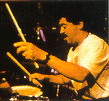
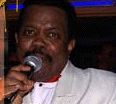

Pictured
above: Nicky Marrero and Camilo Azuquita. Photo credits: Ralph Weber/Enja
Records and Eddie Kuligowski, respectively. Down: 1977
promotional photo. Back row: Dave Perez, Lionel Sanchez, Joe
Grajales, and Nicky Marrero. Mid row: Camilo
Azuquita, Rene Lopez, Dick
Mesa, and Alfredo De La Fe. Front
row: founding members Leopoldo Pineda, Sonny Bravo and Johnny
Rodriguez. Photo
courtesy of Fania Records.
Another
former veteran soloist, Camilo Azuquita, filled his vacant spot. Azuquita,
a veteran of bands like Cortijo, Kako and Louie Ramirez, already had an album
his own group, Azuquita Y Su Melao ("Llego y Dijo," not yet released
on CD format) prior to joining Tipica'73. As for the flute spot, Don Gonzalo
would be replaced by a gentleman who not only mastered the Cuban flute idiom
almost as well, but also brought in a ferocious jazz-tinged tenor sax to the
mixture: the great Dick "Taco" Meza. And then, along with the
changes in the band's lineup and orientation (and the new influences brought in
by the newest band additions), there was an urge to broaden the rhythm section,
although this also meant that the conjunto element would be lost. So, the
original two-men percussion team was now enhanced with the addition of another
young veteran of the salsa scene: Fania All-Stars' very own Nicky Marrero.
With an already impressive resume that also included acts like Willie Colon,
Eddie Palmieri, Tipica Novel, Harlow, Ismael Miranda, Machito and Dizzy
Gillespie, Nicky's versatility and his mastery on both timbales and trap drums
fit in right at home within Tipica's new concept. Now with a regular timbalero
on board, of course, Grajales would then settle on congas and Johnny would
remain a bongo player, as well as doubling on coros.
This is the lineup for the band's next album (and a personal favorite):
1977's "The Two Sides of Tipica'73." With Louie Ramirez back again as
the producer, this is perhaps the band's most experimental album ever, as they
blend in the whole gamut: straight ahead salsa, charanga, an orchestral-tinged
bolero ("Hoy"), songo a la Ritmo Oriental, Latin jazz and even a Salsa
Suite. Nicky himself speaks about this album: "We were showing that we
could play not only Latin music, charanga, big band, but we could play songo -
that's where the drums came in. What was coming out of Cuba: Changuito (Jose
Luis Quintana, the creator of songo and at the time still a member of Los Van
Van) and Los Ritmo Oriental. We could play here like we could play in Cuba.
We could play jazz like we could play charanga, Machito style and New York
style. That's what it (the album) basically meant." Besides the
danceable tracks like "La Botija de Abuelito" and Beny More's standard
"Tumba Tumbador" (in fact, the album's only two singles), the rest of
that album was actually a showcase for the band's cast of characters. The
opening and closing tunes of this album were two instrumental Latin jazz cuts:
Machito's "Bongo Fiesta," a showcase for Johnny Rodriguez's bongos
that also included a tricky 19/4 mozambique bridge with solos from Meza on sax
and Alfredo on violin; and Tito Rodriguez's signature track "It's A Gay
World" (or "El Moldo De Las Locas," a composition by his sax
player Aaron Sachs), this time a showcase for Nicky on timbales (with another
rare appearance by Sonny on scat vocals). "Yo Bailo De Todo," a tune
by Ritmo Oriental, is treated here to a very unusual arrangement: Nicky starts
the tune with a series of percussion effects, followed by a rare trap drums
solo. Then, the main theme is stated in pure salsa fashion, before entering into
songo mood and then to a rock-inflected montuno featuring a monster battle
between De La Fe on electric violin and guest Harry Viggiano (at this time, no
longer with Los Kimbos) on electric guitar before ending on a 6/8 bata rhythm,
provided by Cachete (this time, joined by Hector "El Flaco" Hernandez
on itotele and either Nicky or Joe Grajales doubling on okonkolo).
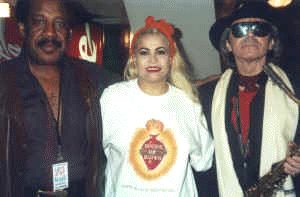
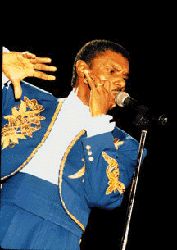
Pictured
above: Mario Rivera (with Yolanda Duke and jazz icon Gato Barbieri) and
Jose Alberto "El Canario." Photo credits: Yolanda Duke's home page (www.yolandaduke.com)
and Mary Kent, respectively.
Azuquita exited the band briefly on October 1977, giving way to a young
Dominican singer named Jose Alberto "El Canario," who, at the
time, was the lead singer of Tito Rodriguez Jr.'s band. One of today's hottest
acts in Latin music, El Canario not only sharpened his skills in Tipica, but
also enhanced the band's sound with both his charisma and his uncommon vocal
timbre, which contrasted nicely with that of Azuquita, who returned to the band
a few months later. With no further changes (except for the addition of Orq.
Broadway's lead singer Felo Barrios, who now joined the band on coros for the
recording sessions), this is the lineup for "Salsa Encendida," the
band's next album. A hot selling album, this 1978 release yielded strong hits
like "Baila Que Baila" (which El Canario later re-recorded as a
soloist), "Los Campeones de la Salsa" (written for them by Louie
Ramirez and also sung by El Canario), "Somos Dos (Con La Mayor Elegancia)"
(the only duo track in Tipica's history, sung by both singers), and a great
version of Irakere's "Xiomara," with a strong rumba feel (with Cachete
wailing on quinto) and Azuquita on vocals. A particularity of this album is the
appearance of a merengue, "La Mujer Dominicana," sung by Azuquita. At
the time, Fania just acquired a recording deal for the Dominican label Karen
Records, home for acts like Wilfrido Vargas and Fernando Villalona then. And,
kind of collecting on the merengue rave of those days, almost all of Fania's
singers and bands included at least one merengue in their recordings as a
vehicle for promotion in the neighboring island. (Tunes like Celia and Willie's
"Pun Pun Catalu," Miranda's "Si No Me Quieres," Quintana's
"Rico Merengon" and Pacheco's "Me Llevaron La Cartera" are
other examples of this 1977-1978 Fania-meets-merengue scheme.) Although clearly
more commercial than their previous release, this album also continued the
increasing intensity of the band's Cuban explorations, as exemplified on "Xiomara,"
"Ti?a Ti?oso" and the closing track "Que Manera de Sentirme
Bien," arranged here as a songo/descarga featuring Alfredo on violin and
Nicky (whom we quote next, talking about this album) on timbales. "We
went back to the dance format and we got a little more conservative on that
album. It was successful and sold. The people liked it because it was
danceable." Such was the impact of this album, in fact, that they went
on a European tour (of course, after the successful presentations of Tito
Puente, Machito and the Fania All-Stars opened that door for Latin bands).
Curiously, it was after a tour of France that Azuquita left the band,
establishing residence in that country (which he still calls home nowadays) and
establishing himself as France's official salsa ambassador.
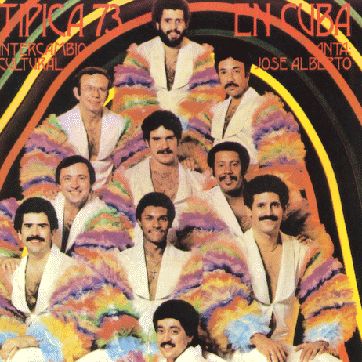
And speaking about the intensity of the band's explorations on contemporary
Cuban music, this common bond between Johnny Rodriguez and some of Cuba's best
musicians led to a radical adventure, as they were invited to perform in that
country. The task: to record an album in Cuba with some of the best musicians in
there. Of course, is not that easy, for not saying impossible, to speak about a
certain group performing AND recording in Cuba without rising suspicious
political inferring. Today, Ry Cooder does the same, reunites Ruben Gonzalez,
Compay Segundo and some of Cuban son montuno's living legends and not only he
doesn't get banned in the US, he gets a Grammy for that effort and an offer to
make a movie based on it. Of course, this is now in the 90's, and not the back
then in 1979's reality; when, despite cultural get-togethers like CBS'
"Havana Jam," Cuban/American relationships were really tense.
Knowingly, Leopoldo Pineda opposed that idea. "I always opposed to that
Cuban trip. I told both Sonny and Johnny 'that little trip will cost us dearly.
Were gonna be f? if we ever make that trip.' And that's what exactly
happened." So, in fact, Leopoldo was out of the trip and, eventually,
out of the band as he, kind of predicting the band's future, landed a more
secure job with Willie Colon's orchestra. His spot on brass section was filled
not by another trombonist, but by a veteran session master whose gained respect
into the Latin musicians' community was unquestionable, up to a point that his
code name was El Comandante (The Commander, in English): woodwinds virtuoso Mario
Rivera. Also of Dominican heritage, this huge man's tour and recordings
resume already included a virtual who's who of Latin music: Tito Puente, Tito
Rodriguez, Machito, Dizzy Gillespie, Justo Betancourt, Cortijo, Celia Cruz, Joe
Quijano, Willie Colon and Louie Ramirez, amongst many others. For yet unclear
reasons, Joe Grajales didn't make that trip to Cuba either, although he never
left the group. So, with The Commander on board and with Cachete on congas (and,
of course, the iya bata drum) and Felo Barrios on coros, up to Cuba they went.
Once again, Nicky narrates what happened there: "We were the first band
to go (from here) to Cuba after 23 years more or less. The first Latin band from
US. All of the screaming, we saw all the top drummers from Cuba and all the top
bands. We stayed there two weeks on these lodges called "El Megano."
Every day during breakfast, they would give out pieces of paper to write down
bands we wanted to see. For 14 days, 5 or 6 bands would come just to play for
us. Not because there was a dance, there was no dance, we were just there and
each one would come and play for us. We recorded an album with some of the 'baddest'
musicians there." Of course, please note that here, the word 'baddest,'
an incorrect augmentative of 'bad' (the correct one is 'worst') means actually
'best' in today's hip parlance. The bad boys who Nicky refers in his quote were
none other than the legendary Aristides Soto, a.k.a. Tata Guines (one of the
founding fathers of modern conga drumming), tres player Ni?o Rivera, trumpet
pioneer Felix Chappotin, the late legendary timbalero Guillermo Barretto, "Estrellas
de Areito" founder and trombonist Juan Pablo Torres (who defected later in
1992), Orquesta Aragon's Richard Egues (master flutist), Felo Bacallao and Tony
Ta?o (who also acted as the recording director for this album); and, on a cameo
appearance, percussion masters Changuito, Raul "Yulo" Cardenas, Eddie
Perez (not El Gran Combo's co-leader) and Pello El Afrokan (the creator of the
mozambique rhythm, who is mentioned on the album but erroneously omitted in the
credits). The aforementioned album's title was "Tipica'73 in Cuba,
Intercambio Cultural." This masterpiece, according to Venezuelan music
critic Cesar Miguel Rondon, brought salsa music to full circle, as the new
sounds of top salsa musicians from the U. S. were finally exposed to the
tradition of the Cuban son and rumba masters of yesterday and vice-versa. The
Cuban guests, in fact, interacted seamlessly to top charts written by Sonny and
Luis "Perico" Ortiz (the rumba opener "Muriendome De Risa,"
with Guines and Cachete laying the rhythm and solid solos by Alfredo and Rene),
as well as cooperating with some charts of their own, like the great hit "Ese
Animal," by Tony Ta?o. A
great example of son-meets-salsa-instrumentation is presented on the hit
"Un Pedacito," which showcased guests Chapottin and Ni?o Rivera, and
Sonora Matancera pianist Javier Vazquez's "Lio," a charanga vehicle
for Richard Egues, is enhanced by Cachete's bata drumming and Sonny's quoting of
a pop standard ("Sun Goddess") in the bridge. Of course, an example of
straight-ahead salsa had to be included, so Puerto Rican composer Johnny Ortiz
contributed the track "Majestad Antillana," which includes a terrific
solo by Sonny. Finally, Tata Guines turns loose with a solo intro to
"Fiesta De Tambores" (where Mario Rivera's ferocious baritone sax
gives the tune a definite be-bop jazz flavor), as well as contributes the
closing tune: the descarga "Pa' Gozar," where Tipica gives way to a
jam session where all the guests display their talent. Despite the overall
beauty of this album, most Cubans in the U. S. saw this career move from a
political point of view instead of a musical point of view. Therefore, the
downhill road began for the band as censorship, persecution and eventually
banning from certain Cuban-American owned clubs and media began interfering with
business.
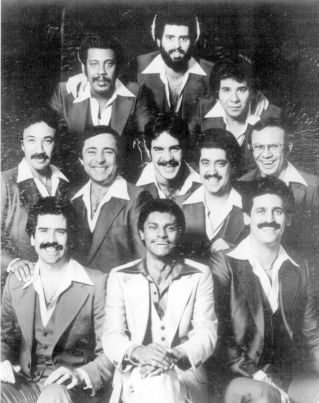
Tipica'73 promotional photo from 1980.
Photo courtesy Fania Records.
Of course, this didn't prevent them from delivering quality music, as in 1980
they record another gem: "Charangueando con la Tipica'73," the band's
tribute to the charanga tradition. Although virtually unheard in Puerto Rico,
this album cemented the band's status as the "musicians' ensemble par
excellence" in New York, at least while the Cuban pressure was still mild.
Here the band included great versions of Tito Puente's "A Donde Vas"
(an arrangement by Sonny Bravo, who recently re-arranged it for its original
author on the album "Dancemania'99") and Cachao's "Chanchullo"
(where Alfredo, Rene and the whole percussion section are showcased), as well as
signature Cuban charanga standards like "Yo No Camino Mas." Even an
overly recorded standard like Rafael Hernandez's "Cachita" sounded
fresh and up to date in Tipica's style. For a late time surprise, this album
ends with an authentic Cuban comparsa, with guest legend Mike Collazo sitting in
on trap drums. On a curious note, it's worth noting that Leopoldo Pineda,
although no longer a regular member of the band, contributed his trombone
playing for this album.
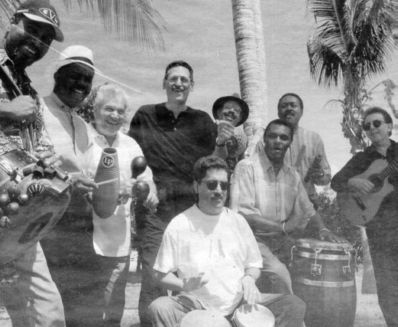
Above:
part of the 1999 edition of Tipica'73, on a photo session prior to their April
16 concert in Puerto Rico: from top left: Cachete Maldonado, Camilo
Azuquita,
Adalberto Santiago, Sonny Bravo, Leopoldo Pineda, Tito Allen
and Nelson Gonzalez. On front, Nicky Marrero on bongos and "El Canario" on conga.
(This photo by Jose Rodriguez/El Nuevo)
Until 1995, this would have been the end of this essay on Tipica'73, but a
successful Puerto Rico concert reunion of some of the band members (Johnny,
Sonny, Nicky, Nelson, Leopoldo, Cachete, Adalberto and Tito Allen) led to a
series of follow-ups in 1999, ending with a 25th anniversary concert
in April 16, where all the band's four singers, as well as the musicians listed
above, coincided on stage for the first time in years. That concert was recorded
digitally and, hopefully, an album with songs from that event will be out before
the end of this millennium. So who knows, there may be another chapter yet to
write for the Musicians' Musicians Band. It may hardly become a full-time
venture again (I don't think Sonny, Johnny and Mario, just for mentioning three
of the key members, would abandon a secure job with Tito Puente to join in such
a venture), but there might be a slight possibility. Until then, thank you all
for the memories. And thank you for la Buena Musica. Aqu?
se enciende la candela?
Bibliography for this article:
Interviews
with:
?
Johnny
Rodriguez, by Martin Cohen (http://www.congahead.com/)
?
Jose
Alberto "El Canario," by Mary Kent (www.digido.com/mkweb)
[*
Note: the interviews with an asterisk (*) preceding them were done in Spanish.
Translations for this article by Tommy Muriel]
?
"El Libro De La
Salsa," by Cesar Miguel Rondon (Venezuela, 1979)
?
"Swing Latino,
Gente Caribe, Vol. 1," by Angel Mendez (Venezuela, 1985)